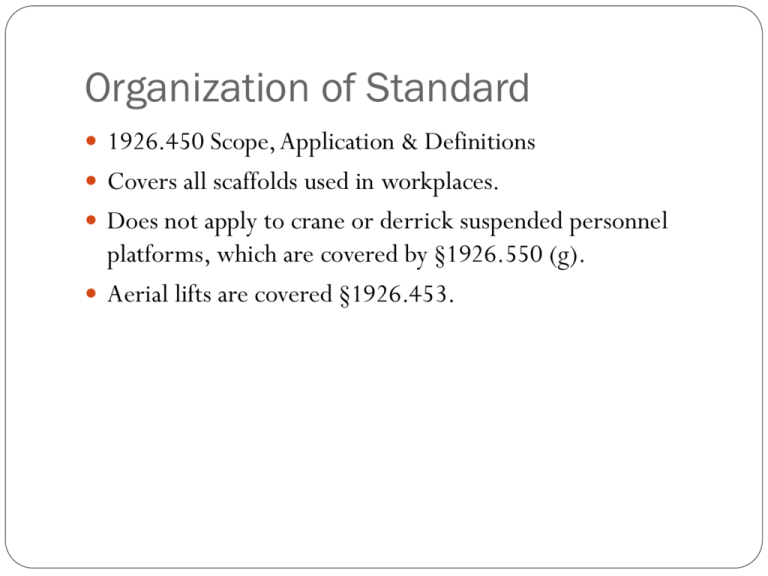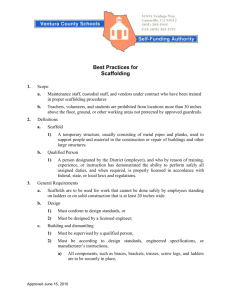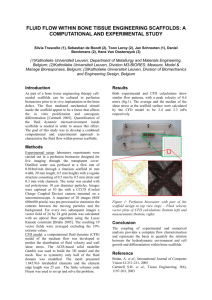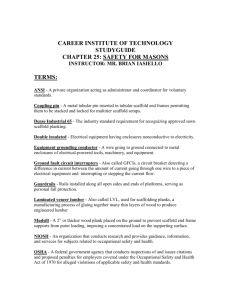Week 11 Power Points
advertisement

Organization of Standard 1926.450 Scope, Application & Definitions Covers all scaffolds used in workplaces. Does not apply to crane or derrick suspended personnel platforms, which are covered by §1926.550 (g). Aerial lifts are covered §1926.453. Scaffold Competent Person Knowledge of structural integrity Maintenance of scaffolds Effects of potential hazards Knowledge of standard 4. General Requirements 1926.451 (a) Capacity Support without failure four times intended load (personnel, equipment and supplies) Designed by a qualified person and built and loaded to design. Connections to roof and floors four times the tipping moment Suspension ropes & hardware 6 times intended load 1926.451 (b) Scaffold Platform Construction Planked as fully as possible Gaps to 1 inch or less In some cases, up to 9 1/2 inch opening space between planks and uprights Does not apply during erection and dismantling 1926.451 (b) Scaffold Platform Construction Platforms at least 18 inches wide Where not feasible to meet the 18 inch requirement, you must install guardrails or PFAS Ladder jack, pump jack, and roof bracket scaffold at least 12 inches wide 1926.451 (b) Scaffold Platform Construction Front of scaffold no more than 14 inches from face of work For outrigger scaffolds 3 inches, for plastering 18 inches 1926.451(b)(4): Each scaffold platform shall extend over its end support at least 6 inches. Violation: The right platform is not 6 inches over the pump jack bracket. 1926.451 (b) Scaffold Platform Construction Platforms less than 10 feet, max. extension over support 12 inches and platforms over 10 feet, max. extension over support 18 inches Overlap platforms only over support, minimum overlap 12 inches unless nailed Planks laid at angles other than 90º laid first under planks laid over supports at 90 º 1926.451 (b) Scaffold Platform Construction No painting of scaffold planks or mud sills No mixing components from different scaffolds unless they match 5. 1926.451 (c) Supported Scaffolds Guys, ties or braces required at the 4:1height ratio and then: Repeated every 20 feet for scaffolds three feet wide or less Repeated every 26 feet scaffolds more than three feet wide Installed at each end of the scaffold, with horizontal spacing not to exceed 30 feet 5. Supported Scaffolds Bracing required to prevent tipping for all eccentric applied loads Scaffolds must bear on base plates and mud sills or other firm foundation Footings rigid with no settling or displacement 5. Supported Scaffolds Unstable objects shall not be used to support scaffolds or platform units. Unstable objects shall not be used as working platforms. 1926.451(c)(2)(i): Footing shall be sound, rigid, and capable of supporting the loaded scaffold without settling or displacement. Violation: Soil is undercutting beneath the plywood because it was not compacted and protected from water. 5. Supported Scaffolds Poles, legs, posts, frames, and uprights plumb and braced 6. 1926.451 (d) Suspended Scaffolds Outrigger beams made of structural metal or equivalent and restrained to prevent movement. 6. Suspended Scaffolds All suspended scaffold devices must rest on surfaces capable of supporting four times the rated load of the hoist 6. Suspended Scaffolds Only specifically designed counterweights allowed, counterweights must be non-flowable material Counterweights secured to outrigger beams by mechanical means Counterweights not removed until scaffold is disassembled 6. Suspended Scaffolds Tiebacks secured to structural anchorage, includes sound structural members but not standpipes, vents, or conduit Support devices (cornice hooks, parapet clamps) made of steel or equivalent and supported by bearing blocks Tiebacks set perpendicular to building face 6. Suspended Scaffolds Four wraps minimum on winding drum hoists Use of repaired wire rope prohibited Wire rope inspected by CP prior to each shift Damaged rope must be replaced 4 wraps at lowest point of hoist travel 7. 1926.451 (e) Scaffold Access Scaffold more than two feet above or below a point of access, ladders, stairs, ramps or other similar access provided No cross braces for access! Hook on ladders positioned so as not to tip the scaffold Bottom rung within 24 inches of supporting level Over 35 feet, rest levels every 35 feet 1926.451(e)(1): Safe access shall be provided to scaffolds. No violation: Ladder arranged so that worker can step onto scaffold directly from the ladder. 7. Scaffold Access Hook-on ladders compatible with scaffold used Ladder Rungs: Minimum rung width of 11.5 inches (prefabricated access 8 inches minimum width) Rungs uniformly spaced 16.75 inches maximum rung spacing 7. Scaffold Access Stair rails provided on scaffold stair towers Handrails smooth with no hazardous projections and 28 to 37 inches high Slip resistant treads on stairs and landings 18 inches wide 28" to 37 " 40º to 60º Riser height uniform, within 1/4 inch 7. Scaffold Access Ramps and walkways above 6 feet require guardrails Maximum pitch: rise of one for run of three (20º) Rise higher than one in eight require cleats 14" 1 8 8. 1926.451 (f) Scaffold Use No moving of scaffolds with employees on them unless designed by PE for such For movement of mobile scaffolds see .452 (w) Safe distance from electric lines: Insulated lines: Less than 300 volts = 3 feet 300 volts to 50 kilovolts = 10 feet Over 50 kilovolts = 10 feet plus .4 inches for each additional kV; or twice the length of the line insulator but never less than 10 feet 8. 1926.451 (f) Scaffold Use No loading in excess of intended or rated load Lean-to scaffolds prohibited CP to inspect for defects each shift Damaged scaffold repaired, replaced or braced 8. Scaffold Use Scaffolds erected, moved, dismantled, or altered only under the supervision and direction of a competent person qualified in scaffolds Access scaffolds with snow/ice only to remove Swinging loads near scaffolds must use tag lines Debris shall not be allowed to accumulate on platforms. 8. Scaffold Use No increasing working height with makeshift devices Ladders only used on scaffolds if: Platform units secured Ladder placed against other surfaces, scaffold secured Legs on same platform or stabilized Ladder legs secured 9. 1926.451 (g) Fall Protection Fall protection required above 10 feet Boatswains' chair, catenary scaffold, float scaffold, needle beam scaffold, or ladder jack scaffold shall be protected by a personal fall arrest system; Single-point or two-point adjustable suspension scaffold shall be protected by both a personal fall arrest system and guardrail system; 9. Fall Protection Guardrail systems shall be installed along all open sides and ends of platforms. Guardrail systems installed before scaffold is released for use by employees other than erection/dismantling crews. 1926.451(g)(1): Guardrails are required at all open sides and ends of scaffolds. Violation: Ends are not guarded on this narrow scaffold. 9. Fall Protection Guardrails 38 to 45 inches high, or higher if conditions warrant Suspended scaffolds where PFAS is required, guardrails of 36 to 45 inches Suspension scaffold hoists may be used as endrails if they prevent worker passage Toprail strength on suspended scaffolds withstand 100 pounds, all other scaffold toprails 200 pounds 9. Fall Protection Crossbracing is acceptable in place of a midrail when the crossing point of two braces is between 20 inches and 30 inches above the work platform or as a toprail when the crossing point of two braces is between 38 inches and 48 inches above the work platform. The end points at each upright shall be no more than 48 inches apart. 9. Fall Protection Overhand bricklaying operations from a supported scaffold protected from falling from all open sides and ends of the scaffold (except at the side next to the wall being laid) a personal fall arrest system or guardrail system For all scaffolds not otherwise specified, each employee protected by personal fall arrest systems or guardrail systems 9. Fall Protection Crawling board (chicken ladder) protected by a personal fall arrest system, a guardrail system or by a three-fourth inch (1.9 cm) diameter grabline or equivalent handhold securely fastened beside each crawling board; Self-contained adjustable scaffold protected by a guardrail system when platform is supported by the frame structure, by both a personal fall arrest system and a guardrail system when platform is supported by ropes; 1926.451(g)(1)(i): Employees on a ladder jack scaffold shall be protected by a personal fall arrest system when working above 10 feet. Violation: No fall arrest on the 14 foot high scaffold. 9. Fall Protection Dismantling and Erecting Scaffolds Effective September 2, 1997, the employer shall have a competent person determine the feasibility and safety of providing fall protection for employees erecting or dismantling supported scaffolds. Employers are required to provide fall protection for employees erecting or dismantling supported scaffolds where the installation and use of such protection is feasible and does not create a greater hazard. 9. Fall Protection In addition to meeting the requirements of 1926.502(d), personal fall arrest systems used on scaffolds shall be attached by lanyard to a vertical lifeline, horizontal lifeline, or scaffold structural member. Vertical lifelines shall: Not be used when overhead components are present on single or two-point adjustable scaffolds Fastened to a fixed safe point of anchorage Independent of the scaffold Protected from damage and sharp edges 9. Fall Protection Safe points of anchorage include structural members of buildings, but do not include standpipes, vents, other piping systems, electrical conduit, outrigger beams, or counterweights. Horizontal lifelines shall: Be secured to two or more structural members of the scaffold Horizontal lifelines shall not be attached only to the suspension ropes. Lanyards on horizontal lifelines on suspended scaffolds: scaffold must have independent support line(s) with automatic locking devices, and in number and strength equal to suspension ropes 9. Fall Protection Vertical lifelines, independent support lines, and suspension ropes shall not be attached to each other, nor shall they be attached to or use the same point of anchorage, nor shall they be attached to the same point on the scaffold or personal fall arrest system. 10. 1926.451 (h) Falling Object Protection Requires hardhats In addition to (as necessary): Toeboards Screens Debris nets Canopies When objects are too large, or heavy to be contained by the above-listed measures, place potential falling objects away from the edge from which they could fall and secure 10. Falling Object Protection When employees below could be struck by falling objects the following is required: Barricade area and no access, or; Toeboard installed of sufficient length Material piled higher than toeboard must be screened, from platform to top of guardrail 11. 1926.454 Training Each employee who works on scaffold trained to recognize and avoid hazards including: Electrical hazards, Fall hazards, and; Falling object hazards in the work area; Proper use of the scaffold 11. Scaffold Training Proper procedures for fall protection, and falling object protection systems Maximum intended load Any applicable regulations 11. Scaffold Training When the employer has reason to believe that an employee lacks the skill or understanding needed for safe work involving the erection, use or dismantling of scaffolds, the employer shall retrain each such employee so that the requisite proficiency is regained. New hazards New equipment Lack of retention or proficiency 13. 1926.452 (k) Ladder Jack Scaffolds 1926.453(k)(1): Ladder jack scaffolds shall not exceed a height of 20 feet. Violation: Scaffold was 26 feet high. Ladder Jack Scaffolds 1926.452(k)(5): Ladder jack scaffold platforms shall not be bridged one to another. Violation: Both metal planks resting on a single ladder jack bracket.







